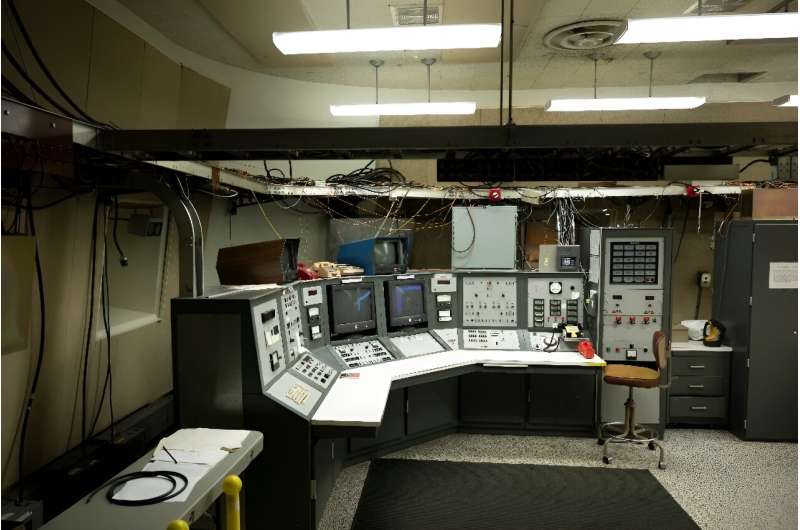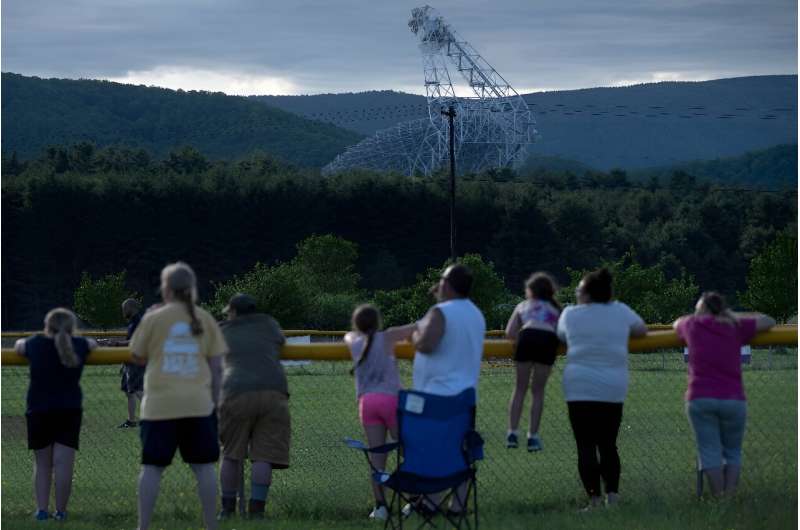Nestled between mountains in a secluded corner of West Virginia, a giant awakens: the Green Bank Telescope begins its nightly vigil, scanning the cosmos for secrets.
If intelligent life exists beyond Earth, there’s a good chance the teams analyzing the data from the world’s largest, fully steerable radio astronomy facility will be the first to know.
“People have been asking themselves the question, ‘Are we alone in the universe?’ ever since they first gazed up at the night sky and wondered if there were other worlds out there,” says Steve Croft, project scientist for the Breakthrough Listen initiative.
For the past decade, this groundbreaking scientific endeavor has partnered with a pioneering, US government-funded site built in the 1950s to search for “technosignatures”—traces of technology that originate far beyond our own solar system.
The search for extraterrestrial intelligence, or “SETI,” was long dismissed as the realm of eccentrics and was even cut off from federal funding by Congress thirty years ago.
But today, the field is experiencing a renaissance and seeing an influx of graduates, bolstered by advances in artificial intelligence and machine learning, as well as recent discoveries showing that nearly every star in the night sky hosts planets, many of which are Earth-like.
“It feels to me like this is something of a golden age,” says Croft, an Oxford-trained radio astronomer who began his career studying astrophysical phenomena, from supermassive black holes to the emissions of exploding stars.

Is ET calling?
The story of the “National Radio Quiet Zone” dates back to 1958, when the US federal government designated a region in West Virginia to help astronomers shield their sensitive equipment from interference.
This means no radio signals, no cellphone coverage, and limited WiFi for the surrounding community. Even the vehicles transporting staff to and from the telescope must run on diesel, as gas cars’ spark plugs generate electrical interference.
“I think the community takes a certain pride in having a premier scientific facility right here,” says Paul Vosteen, who has worked at the observatory for the past eight years.
Standing on the highest platform of the 100-meter giant dish, Vosteen gestures toward the Allegheny Mountains, which act as a natural barrier for radio signals in this bowl-shaped valley.

Radio astronomy began by happy accident when American physicist Karl Jansky discovered radio waves coming from the center of our galaxy, the Milky Way, in 1933.
Since then, it has allowed astronomers to peer beyond the planets, stars, and dust visible through optical telescopes.
From discovering pulsars to conducting sensitive observations of atomic hydrogen that shed new light on galaxy formation—and more recently, detecting fast radio bursts—radio astronomy has been key to numerous advances.
There’s also a long-standing theory that if other civilizations exist, they might emit radio waves, just as ours has since the dawn of radio communication in the 19th century.
In Carl Sagan’s novel “Contact,” humanity is first alerted to extraterrestrial presence by a retransmission of Adolf Hitler’s opening speech at the 1936 Summer Olympics—the first TV signal strong enough to escape Earth’s ionosphere.
A framework for estimating the number of detectable civilizations scattered across the galaxy is found in the “Drake Equation,” devised by the legendary astronomer Frank Drake. Now one of the most recognized formulas in science, it’s even a popular tattoo and T-shirt choice among alien enthusiasts.

‘Chances are improving’
Each year, for a week in late spring, Breakthrough Listen’s team from the University of California, Berkeley, makes a pilgrimage to the telescope during a period of track maintenance for the 17-million-pound structure.
“It’s a relaxing time; every time I’m here, it’s nice being in the National Radio Quiet Zone because there’s no cellphone, no television—it’s a kind of focused environment,” says Matt Lebofsky, lead system administrator.
“Sometimes we need to metaphorically kick the tires, do things ourselves to get a ground truth about how our servers are behaving.”
Inside the server room, the sound of 6,000 whirring hard drives holding 40 petabytes of data—equivalent to 40,000 laptops—makes it impossible to speak without shouting.
“We’re essentially looking for ‘weird things’ in the data,” Croft explains, something that suggests life forms might be trying to reach out, or that scientists are picking up their accidental transmissions.
-

David MacMahon, Breakthrough Listen Initiative Chief Engineer, Steve Croft, Breakthrough Listen Initiative Project Scientist, and Matt Lebofsky, Breakthrough Listen Initiative Lead System Administrator, pose for a portrait in the control room for the Green Bank Telescope.
-

A worker cleans bolts along the track for the Green Bank Telescope, a 100-meter fully steerable radio telescope, at the Green Bank Observatory in the US National Radio Quiet Zone, in Green Bank, West Virginia.
There have been a few moments of heightened excitement in the SETI community, including the 1977 detection of the so-called “Wow!” signal from the constellation Sagittarius, which remains unexplained.
More recently, in 2020, the team identified Breakthrough Listen Candidate 1 from the nearest star system, Proxima Centauri, but after extensive analysis, it was concluded to be human radio interference.
“It’s not deflating at all,” insists Lebofsky. On the contrary, he feels more optimistic than ever, given the vast amounts of data now being collected and processed compared to the early days. “I feel like the chances are improving exponentially every year.”
© 2024 AFP
Citation:
Inside the ‘golden age’ of alien hunting at the Green Bank Telescope (2024, September 2)
retrieved 2 September 2024
from
This document is subject to copyright. Apart from any fair dealing for the purpose of private study or research, no
part may be reproduced without the written permission. The content is provided for information purposes only.